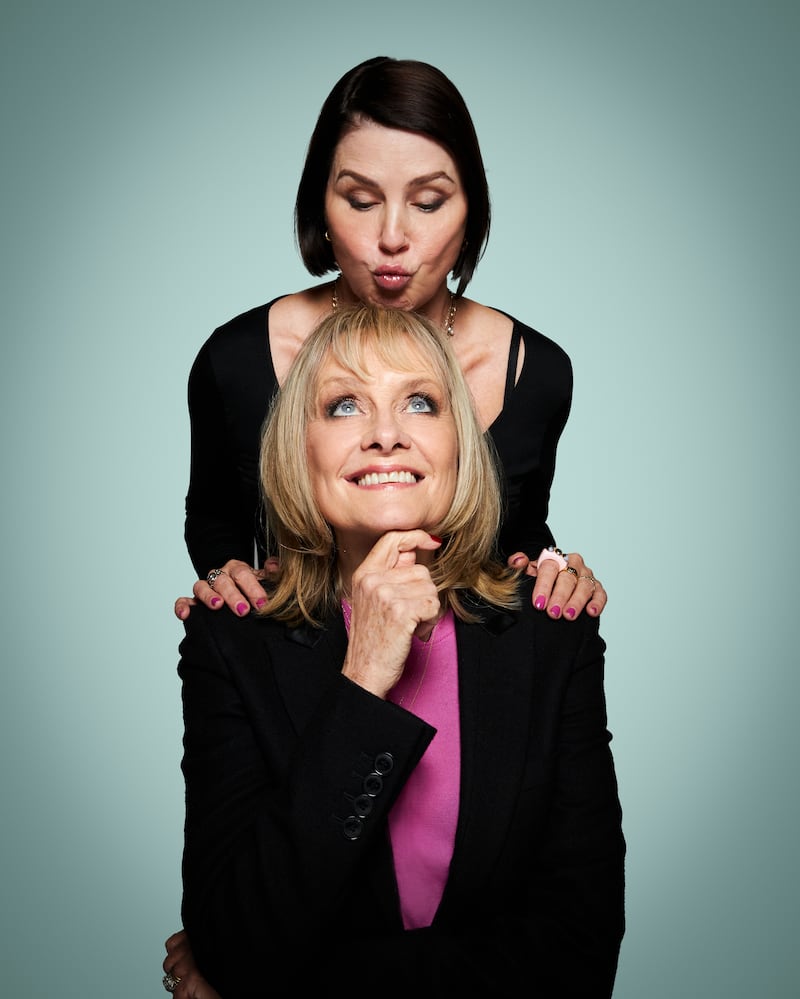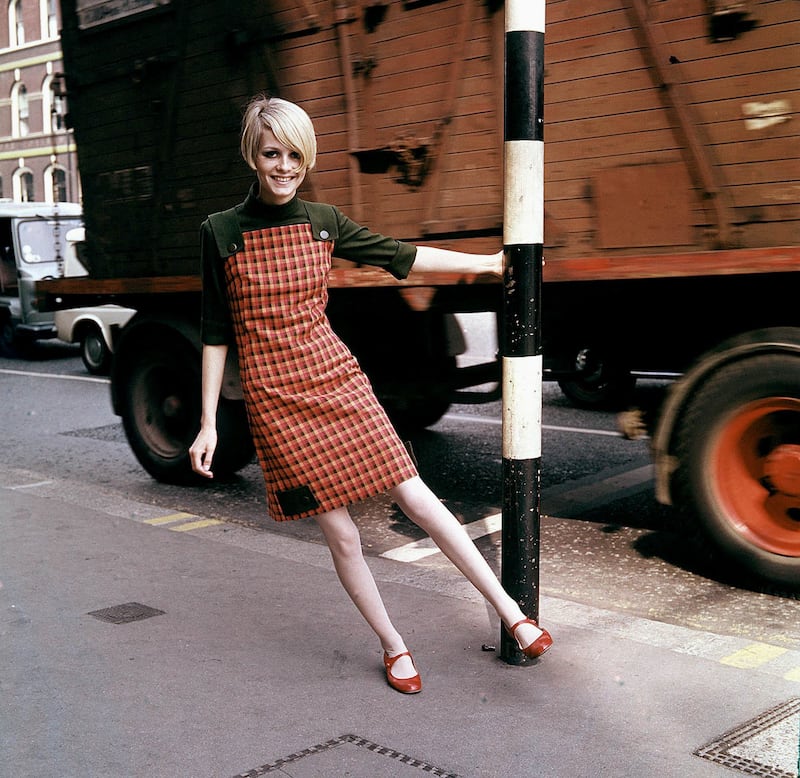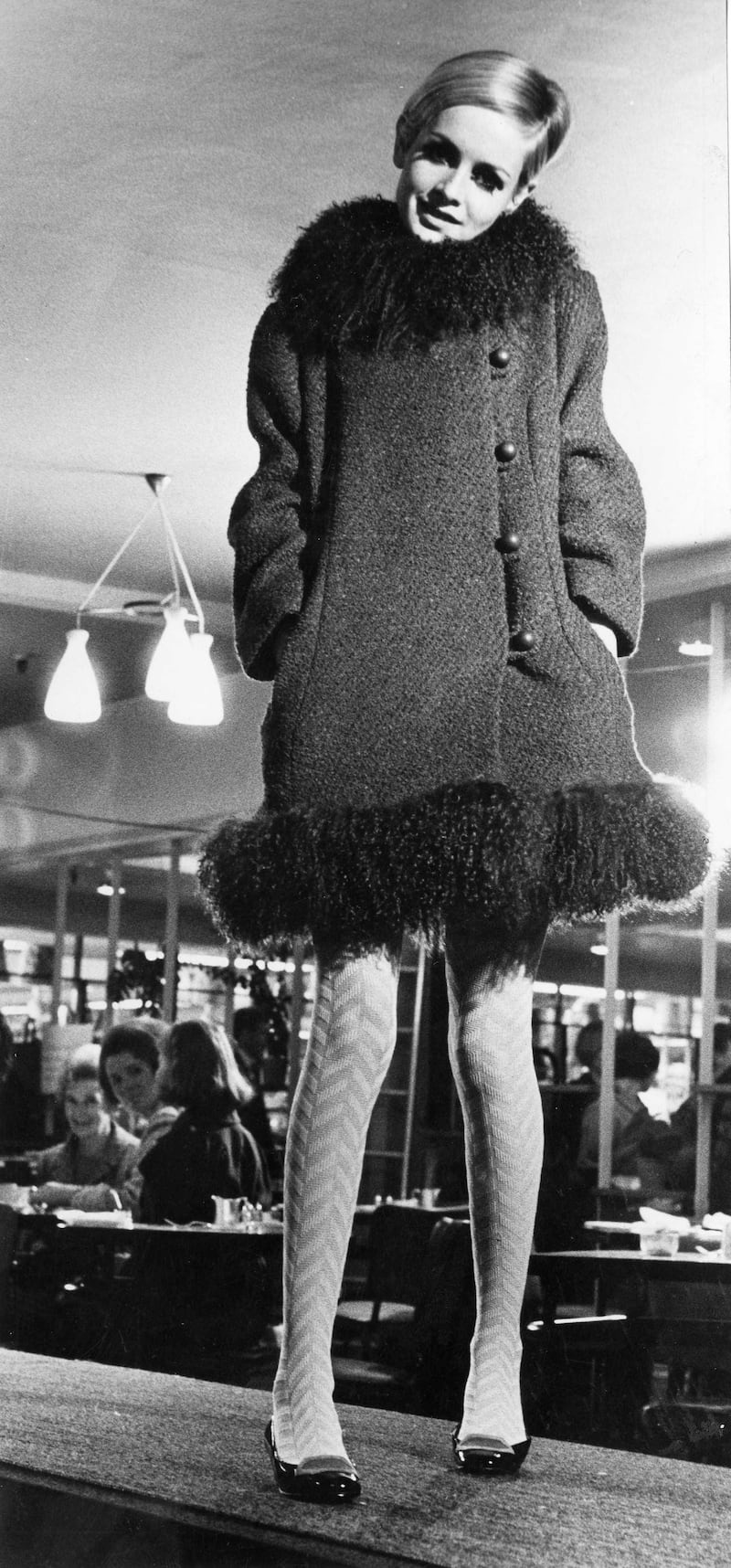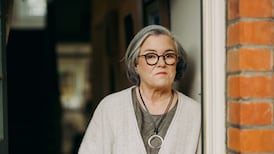It’s Twiggy. A presence in the collective consciousness for close to 60 years. As sparky and amused as we expect her to be. Or is that right? Do I call her Twiggy? She came into the world – on the northwest rim of London – as Lesley Hornby. Does anyone still call her that?
“Um ... my two sisters. That’s just about it.”
“Dame Leslie,” I hope. She deserves that much respect.
“Yeah, I made them kneel down and kiss the ring. Ha ha! Hardly! You over all the storms in Dublin?”
While we’re discussing the weather, I do a bit of pinching myself as I ponder the meaning of this most durable of icons. Twiggy arrived like a pocket cyclone in 1966. As a charming new documentary from Sadie Frost explains, she was spotted, at just 16, by Deirdre McSharry, a fashion correspondent at the Daily Express, and dragged in for a series of life-changing photographs.
To that point (and long after, for that matter) fashion models glowered furiously at the camera with mouths frozen in aristocratic palsy. Twiggy brought in a pixie energy that helped confirm England was shaking off the shackles. For four years she was as much an avatar of the new nation as were The Beatles or the Rolling Stones.
And she survived the succeeding cultural clench. On the big screen in Ken Russell’s The Boy Friend. A presence on light-entertainment TV. Later Broadway shows. We will delve through some sadness, but this looks to have been largely a satisfactory life.
“It’s really funny. I’ve just realised I’m in the middle of a really good novel. It’s called Snow, by John Banville. And he’s Irish, isn’t he?”
He was, indeed, this newspaper’s literary editor during the millennial years.
“Oh, was he? That’s weird. Isn’t it? That’s funny. Have you read it? I can recommend it. It’s set in Dublin in 1957. I got into bed last night to read a page, and I couldn’t put it down.”

Twiggy turns out to be exactly the person you’d expect from her many TV appearances through the years. She cackles like a professional. She tells stories that twist for minutes on end. She takes an interest in you. Just the sort of person you’d expect to survive a terrifying burst of early success.
Twiggy will be discussing all that with Amy Huberman at Dublin International Film Festival this month. It must be an odd thing, even if you’ve remained well known, to carry memories of, for a brief period, having had the world’s most famous face. Frost’s curtly titled Twiggy addresses the fears that came with such attention. Would she recommend the experience?
“I’m not sure ‘recommend’ is the word,” she says. “You can see from the documentary that it literally happened overnight. One week I was in Brondesbury in London. The next week I was in the newspaper and getting phone calls for modelling. And, as we all know now, these things can last a week, they can last three months, they can last a year. Nobody was to know what was to unfold. But then that’s the beauty of life, isn’t it?”
The film has fun working out what set Twiggy apart. It is worth remembering that ordinary folk didn’t then know models’ names. This was a quarter of a century before the supermodel era. Jean Shrimpton, her immediate predecessor at the top of the tree, was famous, but she had nothing like the name recognition of the future Dame Lesley. Twig the Wonder Kid, as David Bowie namechecked her on Drive in Saturday, warmed hearts simply by being there. Her positivity does seem to have been a factor.
“I’m happy to say I was quite a jolly person,” Twiggy says. “I had no reason not to be, really. You’ve got to remember I was 16. All I’d done, really, was go to school, which was fine. I liked school, actually. It was bloomin' exciting. I was travelling the world. I was wearing gorgeous clothes. I was getting paid.”
During her modelling career, Twiggy was forever accompanied by her first manager and sometime romantic partner, Justin de Villeneuve (real name: Nigel Davies). Frost’s film even shows him joining her on chatshows. It is notable that, apparently still with us, de Villeneuve is not interviewed in the documentary.
“We parted company all those years ago,” she says, pleasantly. “So I have no idea, but he is still alive.”
Fair enough. None of our business how that ended. As that section of the film progresses, one can’t help but think of all the 1960s stars who didn’t get the money they deserved. More than a few ended up broke by 1975. I am happy to hear that didn’t seem to happen to Twiggy.
“I was working regularly and I was being paid regularly,” she says. “Some jobs more than others. You have to remember that, when you work for magazines – I think it’s still true today – you get paid very little. It’s for prestige. But then you get the advertising. Also, by then, I was doing the Twiggy dress line. So I was doing okay.”
Coming to the documentary in 2025, one is uncomfortably aware of all the ghastly revelations about how women have been treated in the entertainment industry. Joanna Lumley (excellent value throughout) is cutting about the rudeness and aggression of the era’s photographers. But Twiggy seems to have escaped the worst of such behaviour.
“We’ve learned about all that,” she says. “Luckily, it didn’t touch me because of my good old dad. He was from Bolton, in Lancashire. He was a good northern lad. He was very sensible, very grounded. I love my mum, but my dad was like my hero. My mum suffered a lot with her nerves. He was amazing with me. He was incredible. So I loved and trusted everything he said. When this whole thing happened to me, I had to get permission from him and my mum to leave school.”
Mr Hornby continued to keep an eye.

“It could have been a flash in the pan. But he said, ‘If I deny you this chance you might end up really resenting me.’ Which I wouldn’t have done, because I loved him. But I think it a wise thing to say. He said, ‘The only way I’ll let you do this if you are always accompanied, because I know about these photographers!’ Ha ha! He’d been a master carpenter in the film business. So he knew.”
Twiggy quit the modelling business in 1970, when she was just 20. One can easily imagine a parallel life in which she drifted off into happy obscurity, but Twiggy knew that she had a lot more to give.
Ken Russell offered her the nudge from the dock she required. Fresh off an Oscar nomination for Women in Love, the eccentric director somehow managed to get the most unlikely projects made as the British film industry contracted. In 1971 he released three films: his Tchaikovsky romp The Music Lovers; his decadent masterpiece The Devils (featuring Twiggy in a tiny role) and his version of Sandy Wilson’s 1953 musical The Boy Friend.
Twiggy burned up the screen as the flapper Polly Browne, winning two Golden Globes for her efforts. How did the film come to pass?
“I went to meet Ken about a project that never happened, and Paul McCartney was there, which was hysterical,” she says. “Paul is a dear, dear friend. I’ve known him since that day. But it was so funny. I was so nervous because three years before I was one of the screaming girls at a Beatles concert. And I had to sit very properly opposite Paul McCartney and Ken Russell and behave like a grown up.”
That project got shelved, and Russell moved on to The Boy Friend, but the studio wasn’t keen on casting Twiggy
“They said no at first,” she says. “They wanted a name – an acting name. And he said, ‘I won’t make it without her.’ It’s amazing to have somebody like Ken Russell fight for you.”
Then came a move to the United States and marriage to the actor Michael Witney. Far from drifting off to a quiet retreat, Twiggy was forever shifting and shaping throughout the 1970s. That is her on the cover of Bowie’s Pin Ups. Her appearance on The Muppet Show in 1977 seemed to already acknowledge that the 1960s were drifting into history. Over shots of her modelling days, she warbles a lovely version of The Beatles’ In My Life. “That Twiggy makes my heart sing,” an unusually merry Waldorf says to Statler.
In 1980 she was a strong Eliza Doolittle opposite Robert Powell’s Henry Higgins in an ITV production of George Bernard Shaw’s Pygmalion. She makes the point that – unlike the usually cut-glass Julie Andrews in the original My Fair Lady – she was among the few actors to go in the proper direction: cockney to posh.
“I was the first one to do it the right way round,” she says.
Witney died in 1983, five years after the birth of their much-loved daughter, Carly. A short time later, Powell – referred to jocularly as Jesus because of his lead role in Jesus of Nazareth – introduced her to the suave actor Leigh Lawson. They were married in 1988 and have been together ever since.
“He’s my husband of 36 years, and we’ve been together 40 years this summer,” she says. “I think we’ll be all right. Don’t you?”
Lawson and Twiggy have grown into a celebrity institution. In Frost’s film they prove they are still capable of making each other howl with laughter. That says something.
“We made a vow that when one of us got a good job the other would go with them. So that we weren’t being apart. Which is probably why we’ve been together for 40 years.”

Always eager to please, she tells me a tale of how they travelled to Westport some years back and, directed towards Matt Molloy’s pub, ended up drinking Guinness while the owner, the flautist in The Chieftains, marshalled a wall of the best traditional music.
“We went to a lot of pubs in Ireland, but nothing like that,” she says. “Someone looked down on us and gave us that marvellous evening of Irish music.”
It has been an extraordinary journey. By the time, in 2019, a fateful envelope slapped down on the doormat she must have known she was, in Britain, that dreaded thing: a national treasure. After all, her participation in a famous Marks & Spencer advertising campaign had been credited with a recovery in the store’s fortunes. If Twiggy wears the cardies they must be all right. She thought the envelope a bit fat to be from the tax people.
“And then I opened it. I either misread it or didn’t get it, but I thought it was a CBE,” she says, still delighted. “And it read, ‘If you want to talk to anyone ring this number.’ I got this really nice lady and I said, ‘Am I being offered a CBE?’ She said, ‘No, you’re being offered a damehood. Are you sitting down? I think you should go and have a nice G and T.’ Ha ha ha!”
Both gin and gong well deserved.
Sadie Frost’s documentary Twiggy will be shown at Dublin International Film Festival on Monday, February 24th, followed by a Q&A. Twiggy and Frost will also take part in a public interview with Amy Huberman at the festival’s Tanqueray 0.0% Film Club on Tuesday, February 25th. Twiggy is in cinemas from Friday, March 7th
Dublin International Film Festival 2025: 10 to see
Twiggy and Sadie Frost are just a few of the stars attending this year’s Dublin International Film Festival. Also rolling up will be luminaries such as Ralph Fiennes, Jessica Lange, Ed Harris and Fiona Shaw. Dazzled by the variety? Here are 10 features we can heartily recommend.
Aontas, directed by Damian McCann
The Irish-language-cinema renaissance continues with a taut drama spinning backwards from a bank robbery.
Chain Reactions, directed by Alexandre O Philippe
Fascinating study of how The Texas Chain Saw Massacre influenced five diverse artists.
Good One, directed by India Donaldson
Coming-of-age story set during an adventure in the Catskills.
Maldoror, directed by Fabrice du Welz
Impressive Belgian crime thriller.
Beat the Lotto, directed by Ross Whitaker
One of our best documentarians follows the man who tried to fix the Lotto draw.
On Falling, directed by Laura Carreira
Contemporary tragedy focusing on the trials of a Portuguese warehouse worker in Scotland.
Vermiglio, directed by Maura Delpero
The runner-up at the 2024 Venice film festival focuses on rural Italy at the close of the second World War.
Ready or Not, directed by Claire Frances Byrne
Young Ruby Conway Dunne excels in this 1980s urban drama written by Senator Lynn Ruane.
Riefenstahl, directed by Andres Veiel
Powerful documentary on Leni Riefenstahl, propagandist for the Nazis.
Gazer, directed by Ryan J Sloan
Fascinating drama about a woman without the ability to process the passing of time.
Dublin International Film Festival runs from Thursday, February 20th, to Sunday, March 2nd




















